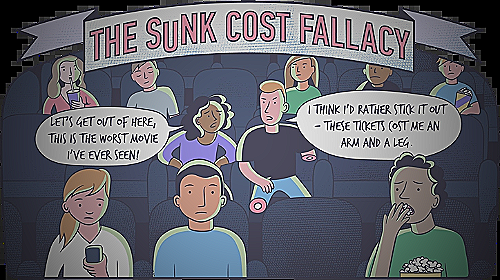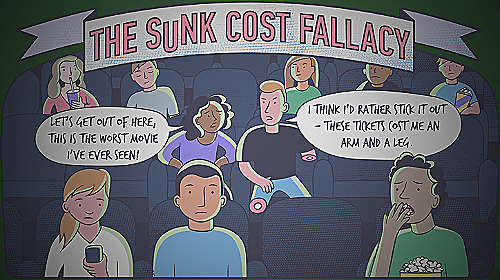Sunk Cost Fallacy- Avoid the Trap Now
Are you struggling to let go of a past investment that is no longer worthwhile? You might be falling into the trap of the sunk cost fallacy.
According to Investopedia, sunk cost fallacy is when individuals continue to invest in something because of the resources already invested, rather than considering the overall future value. In this article, we’ll explore what the sunk cost fallacy is and how it affects decision-making.
We’ll also provide tips on how to avoid this trap and examples of how it can affect different areas of life.
Sunk cost fallacy can affect decision-making in various areas, such as business, personal finances, and even relationships. Business owners may continue investing in a failing project because they have already invested resources, rather than analyzing future returns.
In personal finances, individuals may hold onto a poor investment because they have already spent a lot of money on it, instead of cutting their losses and moving on. In relationships, people may stay in unhealthy relationships because of the time and emotions already invested.
To avoid the sunk cost fallacy, it’s essential to focus on future value and consider the potential outcomes of investing further. It’s important to analyze costs and potential gains,rather than just considering what has already been invested.
Additionally, having a clear plan and timeline can help individuals make decisions based on the potential future value rather than past investments. In summary, the sunk cost fallacy is a trap that many individuals fall into, where they continue to invest in something because of the resources already invested, rather than considering the overall future value.
To avoid this trap, it’s important to focus on future value, have a clear plan and timeline, and analyze costs and potential gains before making any further investments.
Check out this Youtube video: “The Sunk Cost Fallacy: What is it And why does it happen?” to learn how to avoid repeating common financial mistakes.
What is Sunk Cost Fallacy?
Sunk cost fallacy is a type of cognitive bias where individuals make irrational decisions based on the sunk costs—that is, costs that have already been incurred and cannot be recovered—rather than on the expected future outcomes. Essentially, individuals feel that they must continue to invest in a project, even if it no longer makes sense, simply because they have already invested time, money, or other resources into the project.
Asana.com explains that this fallacy can be a real problem with significant consequences, both in our daily lives and in the business world.
Effects of Sunk Cost Fallacy
The sunk cost fallacy can have significant effects on decision making, both in business and personal life. When individuals or organizations invest significant resources into a project or decision, they are often reluctant to abandon it, even if it is no longer serving its intended purpose.
This leads to a number of negative consequences, including:
How It Affects Business Decision Making
- Continuing to invest resources into a failing project or product, resulting in further losses and wasted time and effort.
- Ignoring more promising opportunities and alternatives because of a perceived obligation to continue with the original investment.
- Reducing overall profitability and stifling innovation and growth within the organization.
How It Affects Personal Life Decision Making
- Continuing to pursue an unfulfilling career or relationship out of a sense of obligation or investment, rather than making a change that would lead to greater happiness or success.
- Refusing to cut losses on a personal project or hobby, even if it is no longer enjoyable or beneficial.
- Wasting time and resources on activities that no longer serve a purpose or bring value to one’s life.
Impact on Time Management
The sunk cost fallacy can also have a significant impact on time management, as individuals and organizations invest more and more time into projects and decisions that are no longer serving them. This can lead to a lack of focus and productivity, as well as missed opportunities and delayed progress.

Psychological Factors Behind Sunk Cost Fallacy
The sunk cost fallacy is a common cognitive bias that affects human decision-making. According to thedecisionlab.com, this bias is often driven by psychological factors such as loss aversion, over optimism bias, and the desire not to appear wasteful.
Loss aversion is the tendency to feel the pain of a loss more strongly than the pleasure of a gain. When people have invested time, money, or effort into something, they tend to feel like they are losing something if they abandon it.
This can lead to them continuing on the same path, even when it is not the best course of action.
Over optimism bias is the tendency to place too much weight on positive outcomes while ignoring negative outcomes. People who exhibit this bias tend to believe that good things are more likely to happen to them than bad things, even when the evidence suggests otherwise.
This can make them overly confident in their decisions, even when those decisions are flawed.
The desire not to appear wasteful is another factor that can contribute to the sunk cost fallacy. People often feel like they need to justify their decisions to others, and abandoning a course of action can make them appear foolish or impulsive.
This desire to avoid looking wasteful can make them stick with a decision, even when it is no longer the best choice.
Overall, the sunk cost fallacy is driven by a variety of psychological factors that can make it difficult to make rational decisions. By understanding these factors, individuals can be more aware of their own biases and make better choices in the future.
Examples of Sunk Cost Fallacy
The sunk cost fallacy can be seen in various situations, including business, personal, and historic examples. In business, one common example is continuing to invest in a failing project simply because of the amount of money already invested, despite the probability of success being low.
On a personal level, this fallacy can be observed when someone refuses to sell a car or an item that is no longer useful or valuable, simply because they paid a lot of money for it. They may continue to pay for repairs or maintenance even if the item is costing them more in the long run.
Historic examples of sunk cost fallacy can be found in the Vietnam War, where the US continued to invest troops and resources despite the war becoming increasingly difficult to win. This is also seen in the Concorde project, where despite mounting costs and safety concerns, the project continued simply because so much had already been invested in it.
To illustrate the personal example, imagine someone buying a car that they believed to be reliable and a good value. Years later, the car may have multiple issues and require costly repairs.
Even though it may make more financial sense to sell the car and buy a new one, the person may continue to spend money on repairs because of the initial investment they made in the car. This is a clear example of sunk cost fallacy.

Preventing Sunk Cost Fallacy
To prevent sunk cost fallacy, it is important to first recognize and understand what sunk costs are. Sunk costs are those that have already been incurred and cannot be recovered.
It is important to periodically evaluate the worth of our investments and have the courage to let go if necessary.
Maintaining flexibility is also key in preventing sunk cost fallacy. This means being open to changing your course of action if new information or circumstances arise.
Don’t let the investment of time or money in a project blind you from making the best decision.
Re-evaluating the decision-making process can also help prevent sunk cost fallacy. This involves considering the potential outcomes of a decision, as well as the potential costs and benefits.
It can be helpful to seek out the opinions of others and gather more information before making a final decision.
Illustration of the decision-making process can also be helpful in preventing sunk cost fallacy. By mapping out potential outcomes and weighing the potential costs and benefits, you can make a more informed decision and avoid being swayed by sunk costs.
Remember, it takes effort to detach ourselves from any emotional connections we may have formed with an investment. But by recognizing sunk costs, maintaining flexibility, re-evaluating our decision-making process, and utilizing illustrations to map out potential outcomes, we can prevent sunk cost fallacy and make the best decisions for ourselves and our investments.
What is Sunk Cost Fallacy?
How Does Sunk Cost Fallacy Work?
What are Examples of Sunk Cost Fallacy?
How to Avoid Sunk Cost Fallacy?
Conclusion
It is important to understand the sunk cost fallacy and how it can affect our decision-making processes. Continuously investing in a project or endeavor, even when it no longer makes sense, can lead to negative outcomes.
By being aware of this cognitive bias, we can avoid making irrational decisions and move forward with more informed choices.
As Richard Thaler states, people tend to continue using a product or service once they have invested money into it. However, we should remember that sunk costs should never determine future decisions.
It is crucial to evaluate each situation and determine the best course of action based on its current circumstances and potential outcomes. By doing so, we can avoid being trapped by the sunk cost fallacy and ultimately achieve greater success.

